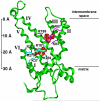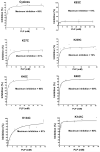The yeast mitochondrial citrate transport protein: identification of the Lysine residues responsible for inhibition mediated by Pyridoxal 5'-phosphate
- PMID: 19002576
- PMCID: PMC2775541
- DOI: 10.1007/s10863-008-9187-1
The yeast mitochondrial citrate transport protein: identification of the Lysine residues responsible for inhibition mediated by Pyridoxal 5'-phosphate
Abstract
The present investigation identifies the molecular basis for the well-documented inhibition of the mitochondrial inner membrane citrate transport protein (CTP) function by the lysine-selective reagent pyridoxal 5'-phosphate. Kinetic analysis indicates that PLP is a linear mixed inhibitor of the Cys-less CTP, with a predominantly competitive component. We have previously concluded that the CTP contains at least two substrate binding sites which are located at increasing depths within the substrate translocation pathway and which contain key lysine residues. In the present investigation, the roles of Lys-83 in substrate binding site one, Lys-37 and Lys-239 in substrate binding site two, and four other off-pathway lysines in conferring PLP-inhibition of transport was determined by functional characterization of seven lysine to cysteine substitution mutants. We observed that replacement of Lys-83 with cysteine resulted in a 78% loss of the PLP-mediated inhibition of CTP function. In contrast, replacement of either Lys-37 or Lys-239 with cysteine caused a modest reduction in the inhibition caused by PLP (i.e., 31% and 20% loss of inhibition, respectively). Interestingly, these losses of PLP-mediated inhibition could be rescued by covalent modification of each cysteine with MTSEA, a reagent that adds a lysine-like moiety (i.e. SCH(2)CH(2)NH(3) (+)) to the cysteine sulfhydryl group. Importantly, the replacement of non-binding site lysines (i.e., Lys-45, Lys-48, Lys-134, Lys-141) with cysteine resulted in little change in the PLP inhibition. Based upon these results, we conducted docking calculations with the CTP structural model leading to the development of a physical binding model for PLP. In combination, our data support the conclusion that PLP exerts its main inhibitory effect by binding to residues located within the two substrate binding sites of the CTP, with Lys-83 being the primary determinant of the total PLP effect since the replacement of this single lysine abolishes nearly all of the observed inhibition by PLP.
Figures





Similar articles
-
Probing the effect of transport inhibitors on the conformation of the mitochondrial citrate transport protein via a site-directed spin labeling approach.J Bioenerg Biomembr. 2010 Apr;42(2):99-109. doi: 10.1007/s10863-010-9280-0. Epub 2010 Mar 31. J Bioenerg Biomembr. 2010. PMID: 20354774 Free PMC article.
-
Relationships of Cysteine and Lysine residues with the substrate binding site of the mitochondrial ornithine/citrulline carrier: an inhibition kinetic approach combined with the analysis of the homology structural model.Biochim Biophys Acta. 2005 Dec 10;1718(1-2):53-60. doi: 10.1016/j.bbamem.2005.10.007. Epub 2005 Nov 8. Biochim Biophys Acta. 2005. PMID: 16321608
-
The yeast mitochondrial citrate transport protein. Probing the roles of cysteines, Arg(181), and Arg(189) in transporter function.J Biol Chem. 2000 Mar 10;275(10):7117-24. doi: 10.1074/jbc.275.10.7117. J Biol Chem. 2000. PMID: 10702279
-
Analysis of the secondary structure of the cys-less yeast mitochondrial citrate transport protein and four single-cys variants by circular dichroism.J Bioenerg Biomembr. 2004 Oct;36(5):429-38. doi: 10.1023/B:JOBB.0000047325.48943.71. J Bioenerg Biomembr. 2004. PMID: 15534390
-
Structure-function relationship in Escherichia coli initiation factors. Identification of a lysine residue in the ribosomal binding site of initiation factor by site-specific chemical modification with pyridoxal phosphate.J Biol Chem. 1981 May 25;256(10):4905-12. J Biol Chem. 1981. PMID: 7014565
Cited by
-
Molecular Mechanism of Citrate Efflux by the Mitochondrial Citrate Transporter CT in Filamentous Fungus Mucor circinelloides WJ11.Front Microbiol. 2021 May 14;12:673881. doi: 10.3389/fmicb.2021.673881. eCollection 2021. Front Microbiol. 2021. PMID: 34054781 Free PMC article.
-
Probing the effect of transport inhibitors on the conformation of the mitochondrial citrate transport protein via a site-directed spin labeling approach.J Bioenerg Biomembr. 2010 Apr;42(2):99-109. doi: 10.1007/s10863-010-9280-0. Epub 2010 Mar 31. J Bioenerg Biomembr. 2010. PMID: 20354774 Free PMC article.
-
Warburg's Ghost-Cancer's Self-Sustaining Phenotype: The Aberrant Carbon Flux in Cholesterol-Enriched Tumor Mitochondria via Deregulated Cholesterogenesis.Front Cell Dev Biol. 2021 Mar 12;9:626316. doi: 10.3389/fcell.2021.626316. eCollection 2021. Front Cell Dev Biol. 2021. PMID: 33777935 Free PMC article. Review.
References
Publication types
MeSH terms
Substances
Grants and funding
LinkOut - more resources
Full Text Sources
Molecular Biology Databases
Research Materials
Miscellaneous

